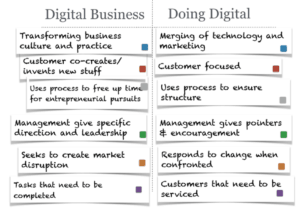
The link between technology and Digital Transformation is undoubtedly strong, but it is worth examining the nature of this relationship to fully understand what Digital Transformation is, what drives it and what it means for our businesses and organisations in today’s digital age.
There are a couple of common beliefs about Digital Transformation and technology.
– Digital Transformation = digitising products and services.
– Digital Transformation is driven by technology therefore to digitally transform we need to adopt new technology.
Let’s look at each.
Digital Transformation = Digitisation
Digitisation is the process of moving our products, processes and services online. We build ecommerce websites, we move our documents and storage to the cloud, we build apps, platforms and make everything faster and more accessible.
Digitisation is necessary for many businesses to survive in the digital age and this is not an argument to say those changes are not necessary or beneficial. It’s important to be able to share documents with co-workers, collaborate on projects, make our products and services more convenient and accessible for our customers.
In this instance, technology is helping to create valuable efficiencies; creating efficiencies however does not lead to Digital Transformation.
Digital Transformation = Technology Adoption
This boils down to keeping up with our competitors. The consequences of falling behind can be brutal. No one wants to see their business fade into obscurity. Avoiding that is a critical challenge for business leaders. However, adopting the latest technology does not result in Digital Transformation.
Keeping Up vs. Creating Competitive Advantage
In both these instances, digitising our products and services, and adopting technology, we are simply keeping up with the changes we see going on in our world. This is not to say that keeping up isn’t important or worthwhile – it most certainly is. The problem is simply keeping up is not enough to win the race.
In businesses where the focus is on digitisation and technology adoption, the responsibility for these changes falls on the shoulders of our marketing and IT departments.
Our marketing and IT departments then go off and redesign websites, work on social media profiles, start PPC campaigns, buy in or spec new systems and maybe even create an app or a new platform. These can be lengthy and expensive projects. For SMEs in particular these can represent a significant investment and the weight of responsibility can feel very heavy.
Then what happens? The business holds its breath and waits expectantly. Will your new website bring more traffic? Will people respond to your ads? Will your customers and staff adopt the new technology? Most importantly, will any of these changes bring growth to the business? As more and more businesses are now finding out – nothing really changes.
Even with some due diligence around these projects there is an element of risk. Focus groups, building a business case and competitor research can only bring a certain amount of comfort.
The Missing Link
The missing link in both these approaches is that the question of ‘why’ has not been fully explored and answered in the digital context. We need to understand why our business needs technology, why our customers might need or use our technology and if our technology is being implemented to create a competitive advantage, how do we know our technology is going to achieve that?
Technology = How
Modern technological advancements have without question changed and shaped the world we live in, but we usually fall into the trap of thinking the technology itself is the driver of change. It’s not. Technology provides the means by which jobs/tasks can be carried out. Technology gives us new capabilities. Technology is a tool.
People need to get from one place to another from time to time. The way in which we choose to do so comes down to a combination of factors – speed, convenience, safety, what ‘stuff’ we need to carry with us, the weather, when we need to get there and cost all need to be considered but there also the parameters of what is available and possible at any given time. A rocket ship, hover board or driverless car might all be technologically advanced options but if you need to go a quarter of a mile through the centre of town on a beautiful day going by foot might be the perfect option that no technology can ever surpass.
Take for example the new rental bike options that are popping up in major cities. They have been successfully adopted by locals and tourists and have proven to be a big hit. The reason for this success does not lie in the technology. Bicycles are not modern tech. There is plenty of room for improvement here – we get wet when it rains, we have to put up with the odd flat tyre and cycling in a skirt or dress is not easy. Even the apps and tech for booking the bikes are not overly flash or ground breaking.
The reason this whole arrangement has been successful is because it solves people’s problems and does so very neatly. From the locations of the bike stations, ease of picking up and dropping off, to the payment facilities, it has all been designed with care. Technology makes it all possible. The value in the whole system comes from designing a lovely solution to the problem.
Driverless cars are another reimagining of the same problem. The technology here is a lot more complicated and advanced, but if the whole system works in a way that meets our needs and operates within the given parameters (such as our roads, traffic systems and governmental restrictions) then there is no reason why they won’t be successful (until someone finally designs and manufactures a hover board or flying car of course).
Asking “Why?”
Answering this question fully is the critical precursor to successful technology implementation. Why do we need it? To find that out we need to ask a whole series of questions. Who wants to use it? What problem does it solve? What task does it help perform? How do we know what the problems are? Are people looking for this solution? Will they adopt it? Will anyone pay for it?
Technology is a Cog in the Machine of Digital Transformation
In the context of Digital Transformation, digital refers to the rapid speed of change we are currently experiencing. The digital revolution is powered by technology – the internet, mobile technology, computer processing, artificial intelligence, machine learning, nanotechnology, robotics and information processors are all tools that we can use to perform tasks in different ways.
Technology is changing how we go about our work, how we communicate, our healthcare, and nearly every aspect of our lives but the technology is not the point. The point is that technology is allowing us to do things faster, more effectively, more conveniently, often more affordably and with greater accuracy than ever before. The point is that we’re trying to do something that matters to us. The technology itself is dispensable. If another gadget or piece of software or tool comes along that helps us to achieve our goals in a better way and within our budget/parameters, then the old technology will become obsolete.
The goal of Digital Transformation is to create digital businesses as opposed to businesses that are ‘doing digital’. Digital businesses survive and thrive in the digital age. Digital businesses are competitive, agile, innovative, customer focussed, great to business with and rewarding and fun to work in.

Technology in a digital business provides the means by which our competitive advantage is delivered. Technology provides the solution to a defined problem experienced by our customers.
Defining and solving the problem is the starting place for creating a winning formula for the business. Doing it better than anyone else in the marketplace creates a bigger win. Creating a life-altering solution to a problem that lots of people experience creates a very big win. Doing it more than once creates longer lasting wins. Perpetually innovating, adapting and improving solutions and solving more problems creates a digitally transformed business.
What are the other cogs in the machine that drives Digital Transformation?
In the initial stages of Digital Transformation, we need 3 people at the table – the CEO, the marketer and the technologist. The CEO/business leader is responsible for defining the problem, asking the pertinent questions, giving direction and making decisions. The marketer’s ultimate job will be to communicate our solution and our value proposition but in the interim, has a valuable role to play in testing the marketplace, gathering the data required to test our ideas and assumptions and finding out if customers are searching for our product/service and if they will pay for it. The technologist is the solution builder.
That should be enough to create the first win. The challenge then lies in sustaining this competitive advantage which is where the other change blocks for digital transformation into play.
Strategy and culture come first. Strategy comes from defining the problems, understanding the customer, the marketplace and the resources that can be leveraged to create our competitive advantage. Strategy sets the direction of travel. Strategy and culture go hand in hand. We need a culture that supports our strategic direction and allows for the experimentation and data gathering involved in testing ideas and assumptions to make those strategic decisions.
Staff and customer engagement is the next change block. Engaging our customers is essential on the road to Digital Transformation. Engagement relies on our ability to provide a product or service that is valued by our customers and by meeting the hierarchy of needs of our people. When we can successfully engage with our staff and customers, it opens the doors to co-creation of innovative products and services that will propel our business further forward.
Process and innovation is the next change block. This is about creating continual cycles of innovation that will keep the machine turning. Our internal processes must align to support the strategy and culture we are trying to foster that will sustain our competitive advantage.
Then comes technology. This is where we start to implement the technology that will make all this happen.
Finally, we need data and analytics. We need to build learning into our organisations. We need to measure our outputs, our successes, benchmark our efforts, score our innovations and use this information constructively to give us the evidence we need to determine future direction. We need to continually analyse our marketplace and gather data about our customers to understand their behaviour and keep an eye on the competition.
We then start again – back to strategy and work through the processes to the next cycle of innovation. This is the engine that keeps those cogs turning.
To sum up: what is the role of technology in Digital Transformation?
Technology is the tool that allows us to get the job done. Technology is a delivery agent, a solution, a cog in the machine. Technology provides a solution to a problem. Defining the problem and understanding the context and desires around that problem is the key to successful technology design and implementation. When it comes to creating a digital business, technology is one of the change blocks that must be addressed to bring about the changes we desire.
Technology gives us the means. It’s what we want to do with it that matters.
To read more about the Ionology Digital Transformation framework click here.
To watch a video on Digital Transformation click here.


